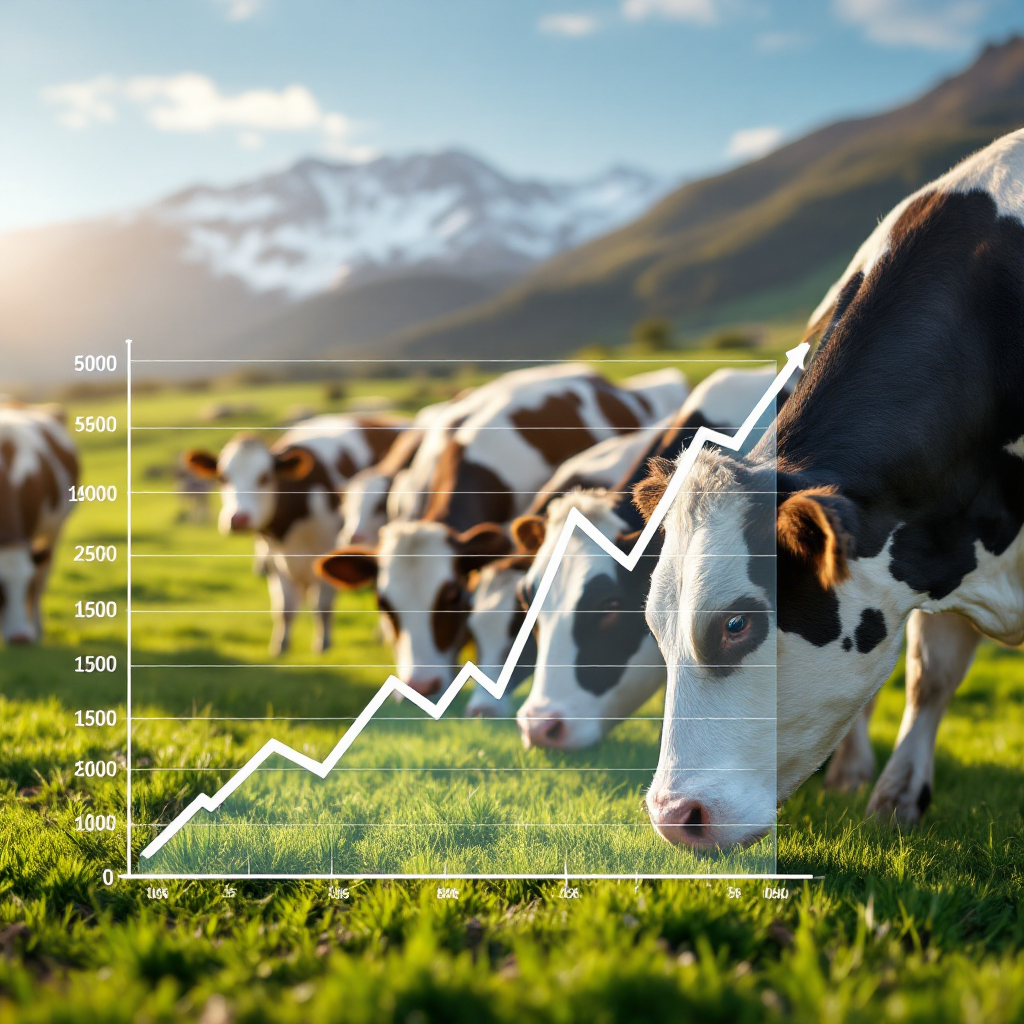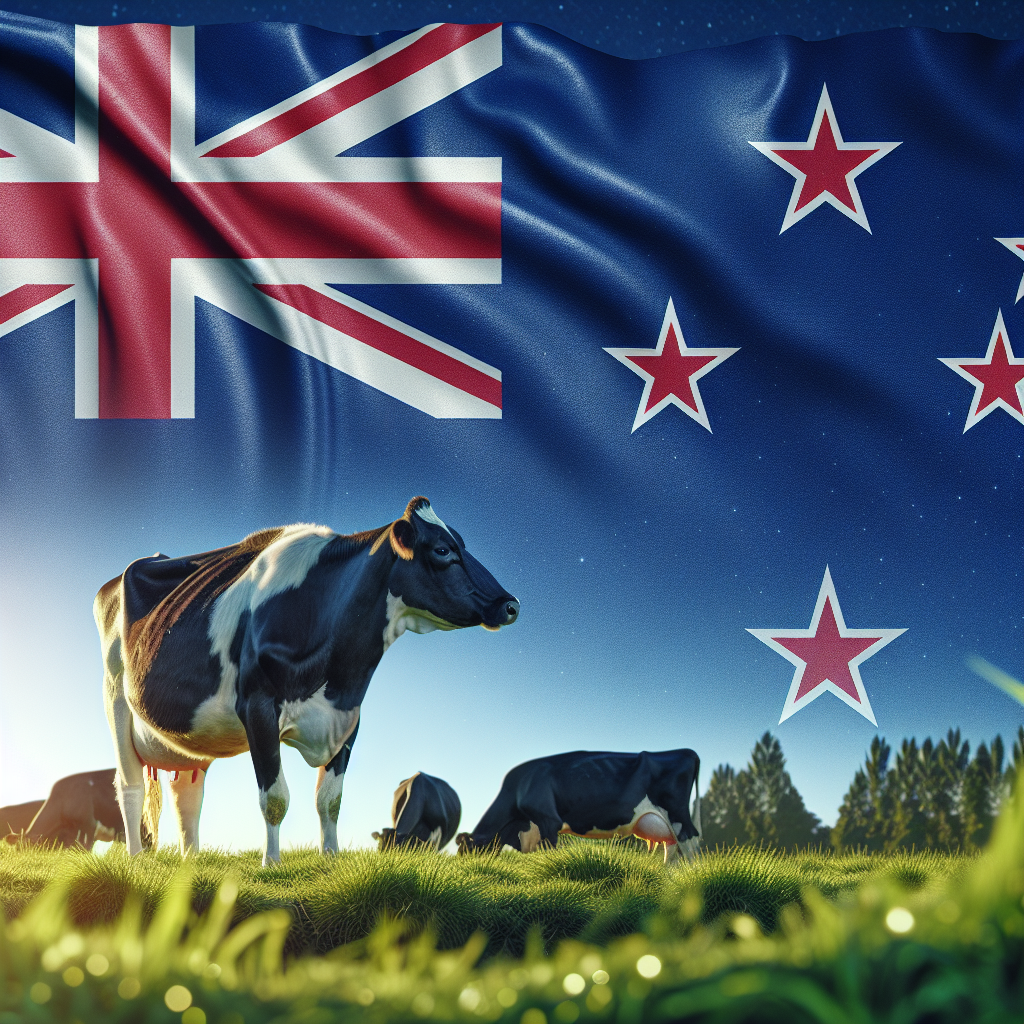Explore New Zealand’s dairy boom and strategic market moves. Ready to seize the growth?
Summary:
New Zealand’s dairy sector shines with a 2.1% year-over-year rise in October output, hitting nearly 6.8 billion pounds and bolstered by a 2.8% increase in milk solids. This growth trend provides stability despite market fluctuations. Fonterra forecasts a lucrative $9-$10 per kgMS, surpassing the $9.30 peak of 2021-22, showcasing a robust outlook. Strategically, Fonterra plans to exit its global consumer business to focus on food service and ingredient sales, alongside divestment from Fonterra Oceania and Sri Lanka, thus enhancing core operations and aligning with global demand. This repositioning promises a strong influence on international markets, paving the way for sustainable long-term growth and greater profitability through reinvestment in advanced farming practices and operational efficiencies.
Key Takeaways:
- New Zealand’s dairy production has significantly increased, showing strong year-over-year output and milk solids growth.
- The rise in Fonterra’s farmgate milk price promises improved profitability for local farmers, with current forecasts exceeding past all-time highs.
- Fonterra is refocusing its business strategy towards food service and ingredients while divesting from its global consumer business, which may create new market opportunities.
- Global market conditions, such as slowing European milk production and recovering U.S. output, provide favorable export prospects for New Zealand producers.
- Recent increases in whole milk and skim milk powder prices at the Global Dairy Trade Pulse event highlight a growing global demand for New Zealand dairy products.
- Ongoing global uncertainties present risks and opportunities for New Zealand’s dairy industry, emphasizing the need for continued innovation and strategic adaptation.

New Zealand’s dairy industry continues to break boundaries, posting stellar production figures that set new benchmarks for milk solids. With an impressive 2.8% year-on-year increase in October alone, kiwi farmers are not merely keeping afloat but are sailing ahead with robust numbers. This remarkable growth has carved out potential market opportunities. New Zealand has the capacity and the motive to influence global trade dynamics significantly. But what does this mean for the global dairy market? Let’s delve into the ramifications of this surge and how New Zealand’s dairy prowess could reshape the industry’s future.
| Month | 2023 Milk Production (Million Pounds) | 2024 Milk Production (Million Pounds) | Percentage Change (%) |
|---|---|---|---|
| June | 1,200 | 1,235 | 2.9% |
| July | 1,315 | 1,355 | 3.0% |
| August | 1,590 | 1,646 | 3.5% |
| September | 1,750 | 1,798 | 2.7% |
| October | 1,900 | 1,940 | 2.1% |
Moo-ving Forward: New Zealand’s Dairy Upsurge Propels Industry to New Heights
New Zealand’s dairy industry is demonstrating robust growth, as evidenced by the recent production statistics. The industry is experiencing a notable 2.1% year-over-year increase in output, with collections closing in on an impressive 6.8 billion pounds. This uptick aligns with October being the peak month in New Zealand’s dairy calendar, which runs from June to May. Additionally, season-to-date production shows an encouraging 4.1% increase compared to the same period in the previous 2023-24 season.
The 2.8% year-over-year rise in milk solids in October is essential to this growth. Given that New Zealand dairy producers receive compensation based on milk solids, this increase translates directly into enhanced profitability. The rise in milk solids is even more significant as it ensures farmers gain financially, notwithstanding potential fluctuations in raw milk volumes or market demand. Consequently, these production gains highlight the strength of New Zealand’s dairy capabilities and ensure its producers’ financial sustainability and competitiveness in international markets.
Fonterra’s Bold Step: Empowering Kiwi Farmers Amidst Global Market Shifts
Fonterra’s recent decision to elevate the farmgate milk price to $9-10/kgMS is a strategic move that holds substantial significance for dairy farmers. This adjustment reflects the buoyant production metrics and robust market demand. It amplifies the producers’ confidence in sustaining and potentially increasing profitability. In an environment where farm margins are critically dependent on milk prices, this increment is poised to offer a tangible boost. With the midpoint of the forecasted price increasing by 50¢ from the previous estimate, it signifies a shift towards unprecedented highs, surpassing the earlier peak of $9.30/kgMS recorded in the 2021-22 season.
Elevated milk prices and reduced third-quarter operating expenses form a promising financial outlook for New Zealand dairy farmers. Lower costs, when aligned with higher revenues from milk sales, inherently lead to improved farm margins. This financial cushioning allows farmers to reinvest in advanced farming techniques, elevate dairy herd health, and optimize operational efficiencies, ultimately contributing to sustainable long-term growth.
Contextually, Fonterra’s moves are not isolated phenomena but embedded within a broader historical framework that underscores a commitment to maintaining a competitive edge in the face of global market fluctuations. As dairy farmers navigate these economic shifts, the industry’s trajectory towards stable, if not enhanced, profitability becomes clearer, potentially inspiring similar strategies in other milk-producing nations.
Redefining Success: Fonterra’s Strategic Shift Towards Profitable Niches
Fonterra’s decision to pivot away from its global consumer business and focus on food service and ingredient sales marks a significant strategic shift aimed at streamlining operations and boosting profitability. By concentrating on these areas, Fonterra can leverage its expertise and resources more efficiently, capitalizing on the growing global demand for food service products.
Divesting from Fonterra Oceania and Fonterra Sri Lanka presents a significant move that could reshape the company’s operational landscape. The potential impacts of this divestiture include a more focused business model and the opportunity to allocate capital and management effort to the more profitable segments of food service and ingredient sales. This shift is expected to enhance the company’s capability to compete and innovate within these targeted markets, which are experiencing robust growth.
As indicated by CEO Miles Hurrell, the exploration of sales or IPOs as divestment options showcases Fonterra’s strategic foresight in ensuring that these businesses can attract the right kind of investment for growth. A sale could provide immediate liquidity and streamline the company’s focus. At the same time, an IPO might offer a platform for these businesses to grow independently, tapping into capital markets to finance future expansions and innovations. Each option has pros and cons, and Fonterra’s choice will likely hinge on current market conditions and long-term strategic goals.
Carving Out a Niche: New Zealand’s Strategic Positioning Amidst Global Dairy Dynamics
The global dairy landscape is undergoing a pivotal transition, marked by a significant deceleration in European milk flows and the nascent recovery of U.S. dairy production. This dynamic shift presents a singular opportunity for New Zealand producers to leverage their robust output. With European supply dwindling, markets that typically depend on these sources are now gazing towards the Southern Hemisphere.
Simultaneously, while U.S. production shows the first signs of rekindled growth, it remains insufficient to satiate the burgeoning global demand for dairy products, particularly in regions heavily reliant on imports. Consequently, with its intensified production and increased milk solids, New Zealand stands poised to fill this void, offering competitive, quality options in global markets.
Such conditions are particularly advantageous when juxtaposed with New Zealand’s low operational costs and recent farmgate price elevations. These factors. Ensure that Kiwi farmers can profit from the rising international demand. Ultimately, these factors weave a narrative of opportunity, positioning New Zealand at the forefront of global dairy exports and potentially solidifying its status further as a leader in dairy excellence.
GDT Pulse: New Zealand’s Dairy Gains Momentum Amid Global Demand Surge
The recent Global Dairy Trade (GDT) Pulse event delivered promising results for New Zealand’s dairy export potential, showcasing significant price increases. Whole milk powder (WMP) surged to $3,910/MT, reaching its highest level since July 2022, while skim milk powder (SMP) settled at $2,895/MT, reflecting an upward trend from the previous week’s GDT auction. These escalations suggest a robust demand for New Zealand’s dairy products internationally.
These developments are more than just promising for New Zealand producers—they’re transformative. As European and U.S. milk production shows signs of slowing, New Zealand is strategically positioned to capture more market share in the global dairy arena. The nation’s ability to meet increased demand with competitive pricing strengthens its foothold internationally. The favorable prices improve farmgate returns and provide an impetus for New Zealand to bolster its export capabilities. This positions Kiwi farmers uniquely to capitalize on shifting market dynamics, driving growth and profitability amidst fluctuating global supply conditions.
These trends indicate a pivotal shift in the broader context of the global dairy market. Rising demand and price enhancements set a new tone for the global dairy trade, potentially reshaping sourcing strategies for significant importers. As New Zealand leverages these opportunities, it underscores its role as a critical player in the ever-evolving dairy production and trade world.
The Bottom Line
New Zealand’s dairy industry is experiencing success, as shown by the remarkable increase in output and milk solids and Fonterra’s strategic realignment to focus on more profitable segments. With reduced expenses and a high farmgate milk price, New Zealand producers are ideally positioned to expand their reach in export markets, particularly given favorable global economic conditions.
As markets shift and new trade dynamics emerge, Kiwi farmers and industry players must remain vigilant, balancing profitability with sustainability and adaptability. Innovation will be vital in maintaining competitive advantage amidst changing consumer preferences and environmental pressures.
As you reflect on these developments, consider how your operations will evolve to navigate these changes and what role New Zealand’s robust dairy sector will play in shaping the future of global dairy markets.
Learn more:
- Global Dairy Market Trends July 2024: Australia’s Rise as Argentina and New Zealand Face Challenges
- Is 2024 Shaping Up a Disappointing Year for Dairy Exports and Milk Yields?
- Asia’s Dairy Boom: Unprecedented Milk Production Soars to New Heights!
 Join the Revolution!
Join the Revolution!
Bullvine Daily is your essential e-zine for staying ahead in the dairy industry. With over 30,000 subscribers, we bring you the week’s top news, helping you manage tasks efficiently. Stay informed about milk production, tech adoption, and more, so you can concentrate on your dairy operations.







 Join the Revolution!
Join the Revolution!





